Medicinal possibilities
The butterfly bush (Buddleja davidii) is a familiar sight for many of us in hedgerows, scrub, alongside railway lines and more vacant spaces. It derives its name from the mauve flower spikes and their attractiveness to bees and butterflies – though sadly fewer are seen nowadays. But what medicinal possibilities does the butterfly bush offer? This plant is in the figwort family or Scrophulariaceae, so it is a relative of the foxglove known for its stimulating heart action (note foxglove is not safe to use as therapeutic and toxic dosage are close). The medicinal butterfly bush may be useful as a diuretic and pain reliever with powerful antimicrobial activity.
Traditional use
In traditional Chinese medicine, Buddleja flower buds (mi meng hua) are used for eye complaints including bloodshot eyes, eye secretions and sensitivity to light. In other traditions, members of of the Buddleja genus have been used for treatment of liver diseases and bronchial complaints. The plant is also used for reducing muscle spasms and as a mild diuretic.
Habit and cultivation
The butterfly bush originates from rocky areas in China and is now naturalised in many parts of the world, especially on dry wasteland. It is a hardy deciduous shrub growing fast to 3 m up to 5 m wide with flower spikes produced from July to October. Capsules of many seeds ripen at the end of summer. It has long arching stems with long narrow green leaves that are velvety grey below. It can grow in a wide variety of soils including poor and alkaline soils. The butterfly bush needs light to grow but is reported to survive well in maritime and polluted areas. Hard pruning is recommended in spring as flowering is mainly on the current year’s growth.

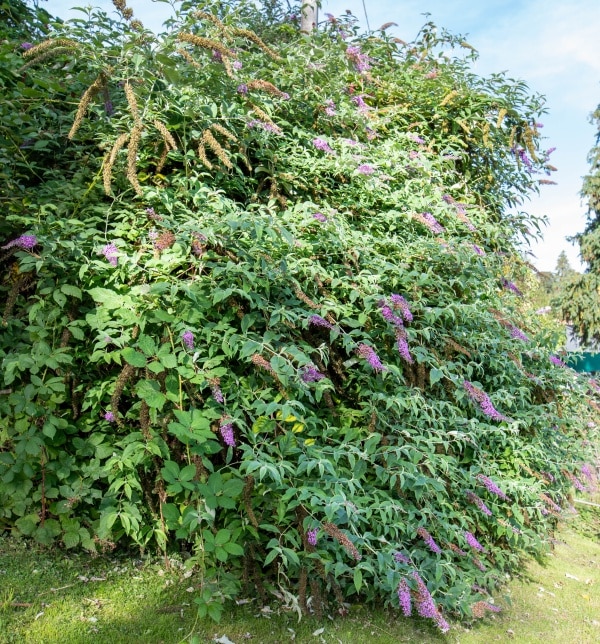
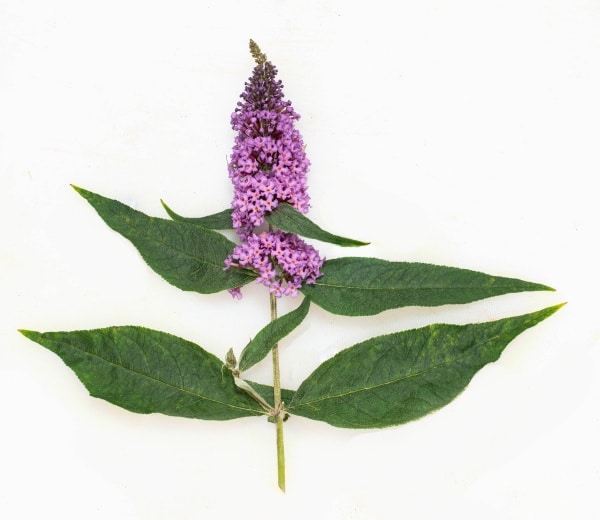
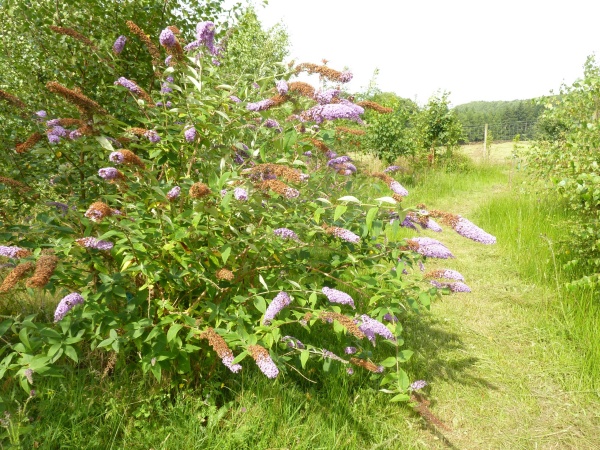
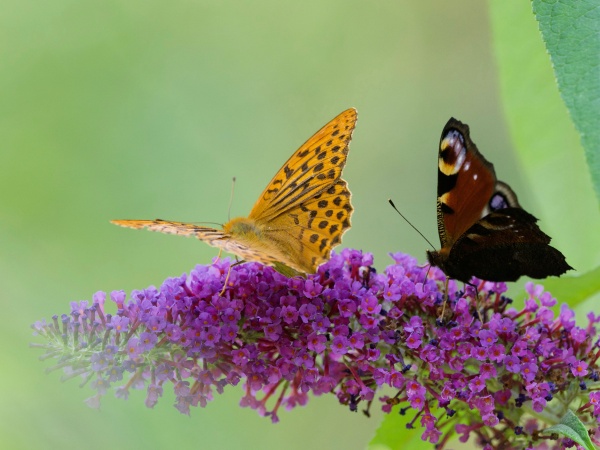
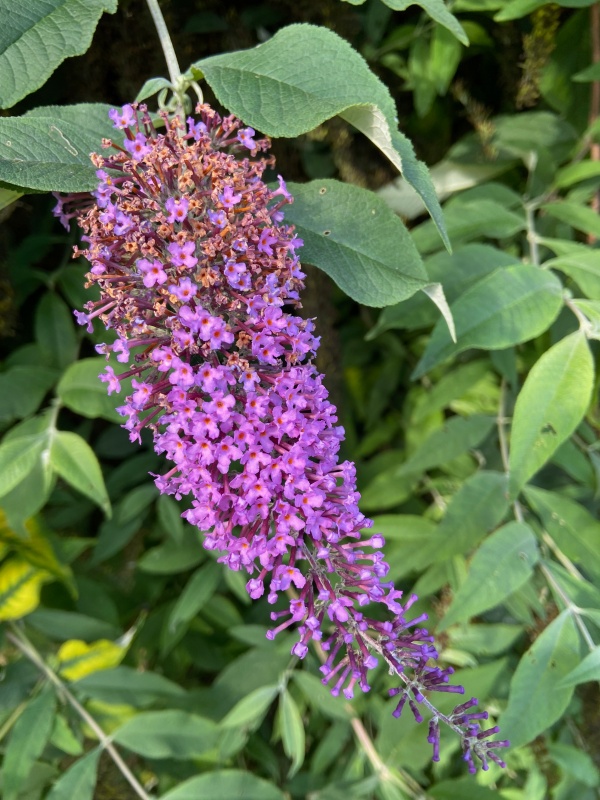
Herbal actions
The medicinal butterfly bush is diuretic, anti-inflammatory, antispasmodic, promotes bile flow, antioxidant and hepatoprotective, antiviral.
Cautions
The butterfly bush should not be encouraged in natural areas outside gardens and managed sites. This is because, although attractive for its nectar, the plant does not offer food for caterpillars and can displace native shrubs which are food sources for insects. Note that this plant will seed freely, and is considered invasive in parts of North America, Europe and New Zealand, and banned in some areas. It is recommended to deadhead the plants to reduce the spread of seed. Do not put the seed-heads into compost.
Research studies
Despite the efforts of pharmacology researchers to point out the potential of this plant there are few research studies. Mostly these studies have focused on identifying key constituents and examining the effect of flower bud or leaf extracts on pathogens in the laboratory. The leaves of Buddleia species contain sesquiterpenes, iridoids, lignans and flavonoids. One of the phenolic constituents is verbascoside which is anti-inflammatory and antimicrobial, and has been shown as effective against the bacteria of Staphylococcus aureus. The flower buds of Buddleja officinalis have been found to be antioxidant and anti-inflammatory. The leaves of related Buddleja species have been shown in an ethanolic extract to be antibacterial, antifungal, and antiviral, and offering much potential as a topical antiseptic.
Harvesting and use
Best used externally, seek professional advice if you want to use the medicinal butterfly bush internally. For home use the flower buds are harvested in spring and used fresh or dried, and the flowers can be dried or used fresh to distil as a fragrant hydrosol. This plant is ideal for an antiseptic poultice for insect bites and other skin complaints. The leaves can be pounded or shredded fresh for use, or an infusion made to apply to the skin.
More information
If you would like to learn more about how healing trees and shrubs work then check out our short online course ‘Medicinal Trees and Their Healing Properties’, more details …
References
Houghton PJ. Ethnopharmacology of some Buddleja species. Journal of Ethnopharmacology 1984; 11: 293-308.
Huang F-B, Liang N, Hussain N, Zhou X-D, Ismail M, Xie Q-L, Yu H-H, Jian Y-Q, Peng C-Y, Li B, Liu B, Chen S-H, Peng Q-H, and Wang W. Anti-inflammatory and antioxidant activities of chemical constituents from the flower buds of Buddleja officinalis. Natural Product Research 2022; 36: 3031-3042. DOI: 10.1080/14786419.2021.1952577.
Raja S and Ramya I. 2016. A review on ethnopharmacology, phytochemistry and pharmacology of Buddleja asiatica.” International Journal of Pharmaceutical Sciences and Research 2016; 7: 4697-4709. DOI: 10.13040/IJPSR.0975-8232.7(12).4697-09.
Youssef S, Altyar E, Omar M and Ashour L. Phytoconstituents, in vitro anti-infective activity of Buddleja indicaLam., and in silico evaluation of its SARS-CoV-2 inhibitory potential. Frontiers in Pharmacology 2021; 2021: 619373. DOI: 10.3389/fphar.2021.619373.
For more references on research studies on medicinal trees and shrubs see The Medicinal Forest Garden Handbook by Anne Stobart, available from the Medicinal Forest Garden Trust here…
